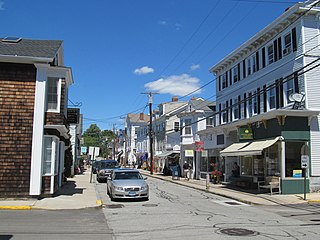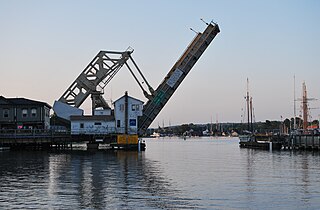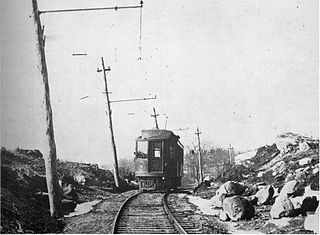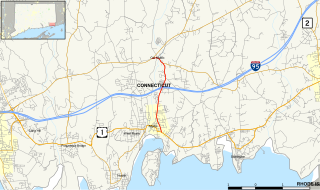
The town of Stonington is located in New London County, Connecticut in the state's southeastern corner. It includes the borough of Stonington, the villages of Pawcatuck, Lords Point, and Wequetequock, and the eastern halves of the villages of Mystic and Old Mystic. The population of the town was 18,545 at the 2010 census.

Streetcars in New Orleans have been an integral part of the city's public transportation network since the first half of the 19th century. The longest of New Orleans' streetcar lines, the St. Charles Avenue line, is the oldest continuously operating street railway system in the world. Today, the streetcars are operated by the New Orleans Regional Transit Authority (RTA).

Groton is a town in New London County, Connecticut located on the Thames River. It is the home of General Dynamics Electric Boat, which is the major contractor for submarine work for the United States Navy. The Naval Submarine Base New London is located in Groton, and the pharmaceutical company Pfizer is also a major employer. Avery Point in Groton is home to a regional campus of the University of Connecticut. The population was 40,115 at the 2010 census.

The Mystic River Bascule Bridge is a bascule bridge spanning the Mystic River in Mystic, Connecticut in the United States. It carries vehicle and foot traffic directly into the tourist district of town via 33 ft-wide (10 m) Main Street.

Southern New England at one time had a large network of street railway lines, including several true interurban streetcars. It was possible to go from New York City to Boston completely on streetcars on at least three routes: via Hartford, Connecticut, Springfield, Massachusetts, and Worcester, Massachusetts; via New London, Connecticut and Worcester, or via New London and Providence, Rhode Island.

The New York, Providence and Boston Railroad, normally called the Stonington Line, was a major part of the New York, New Haven and Hartford Railroad between New London, Connecticut and Providence, Rhode Island. It is now part of Amtrak's high-speed Northeast Corridor.

The Denver Tramway, operating in Denver, Colorado, was a streetcar system incorporated in 1886. The tramway was unusual for a number of reasons: the term "tramway" is generally not used in the United States, and it is not known why the company was named as such. The track was 3 ft 6 in narrow gauge, an unusual gauge in the United States, but in general use by railways in Japan, southern Africa, New Zealand, and Queensland, Australia.
Kitchener Public Utilities Commission (KPUC) was a public utility and transit operator in the Kitchener-Waterloo area from 1927 to 1973.

Route 27 is a north–south state highway in southeastern Connecticut running for 3.21 miles (5.17 km) from U.S. Route 1 in Mystic to Route 184 in Old Mystic.

The Third Avenue Railway System (TARS), founded 1852, was a streetcar system serving the New York City boroughs of Manhattan and the Bronx along with lower Westchester County. For a brief period of time, TARS also operated the Steinway Lines in Long Island City.

The Connecticut Company was the primary electric street railway company in the U.S. state of Connecticut, operating both city and rural trolleys and freight service. It was controlled by the New York, New Haven and Hartford Railroad, which also controlled most steam railroads in the state. After 1936, when one of its major leases was dissolved, it continued operating streetcars and, increasingly, buses in certain Connecticut cities until 1976, when its assets were purchased by the state government.
Sun Publishing Company is a daily and weekly newspaper publisher in southwest Rhode Island and southeast Connecticut, United States. It is a Westerly, Rhode Island-based subsidiary of RISN Operations.

The Warren and Jamestown Street Railway operated a 22 mile line between Jamestown, NY, Warren, PA, and Sheffield, PA. The company was incorporated January 15, 1904 from the consolidation of the Warren and Jamestown Electric Railroad and the Warren and Jamestown Street Railway of Pennsylvania. Operations began September 1, 1905. Operations ceased between Warren and Sheffield on April 1, 1928 and between Warren and Jamestown December 2, 1929.
Route 184 is a state highway in southeastern Connecticut, running from Groton to North Stonington.

The Norwich and Westerly Railway was an interurban trolley system that operated in Southeastern Connecticut during the early part of the 20th century. It operated a 21-mile line through rural territory in Norwich, Preston, Ledyard, North Stonington, and Pawcatuck, Connecticut to Westerly, Rhode Island between 1906 and 1922. For most of its length, the route paralleled what is now Connecticut Route 2.
The Shore Line Electric Railway was a trolley line along the southern coastline of Connecticut, running between New Haven and Old Saybrook with additional branches to Chester and Stony Creek. Unlike most trolley lines in New England, the Shore Line Electric was a true interurban, running large railway-style cars largely on a private right-of-way rather than on public streets. Though its main line was in operation for only 15 nonconsecutive years, the Shore Line Electric briefly acquired a substantial network of trolley lines stretching across eastern Connecticut, including the Norwich and Westerly Railway, the Groton and Stonington Street Railway, and several lines of the Connecticut Company. Most of the trolley line no longer is extant, however, the Shore Line Electric Railway Power House still stands along the mouth of the Connecticut River in Old Saybrook.

Groton was one of the shortest-lived Amtrak passenger rail stations, in service from January to April 1978 during the last incarnation of Amtrak's Clamdigger service. Previous stations at several locations in Groton saw both local and long distance service from 1852 until the mid-20th century.

The Williamsburg Bridge Plaza, sometimes called Washington Plaza or the Williamsburg Bridge Transit Center, is a major bus terminal and former trolley terminal located at the foot of the Williamsburg Bridge in the New York City borough of Brooklyn, one block west of the Brooklyn-Queens Expressway (I-278). It is situated by the boundaries of Broadway, Havemeyer Street, Roebling Street and South 5th Street, south of the LaGuardia Playground. It contains six bus lanes and serves as a terminal for the many MTA New York City Transit Authority bus routes of Brooklyn and Queens that start and end their runs there.
The Rochester Railway Company operated a streetcar transit system throughout the city of Rochester from 1890 until its acquisition by Rochester Transit Corp. in 1938. Formed by a group of Pittsburgh investors, the Rochester Railway Company purchased the Rochester City & Brighton Railroad in 1890, followed by a lease of the Rochester Electric Railway in 1894. The Rochester and Suburban Railway was leased in 1905, extending the system's reach to Irondequoit and Sea Breeze. Rochester Railways was acquired by the Mohawk Valley Company, a subsidiary of the New York Central Railroad set up to take control of electric railways in its territory. In 1909 the holdings of the Mohawk Valley Company were consolidated as the New York State Railways.

The New York and Stamford Railway was a streetcar line that connected the Westchester County suburbs of New Rochelle, Larchmont, Mamaroneck, Harrison, Rye, and Port Chester, with the Connecticut suburbs of Greenwich and Stamford. The company was formed in 1901 when the New York, New Haven and Hartford Railroad combined the Larchmont Horse Railway Company with the Port Chester Street Railroad Company. The Larchmont Horse Railway Company was founded in 1888 by the Larchmont Manor Company to construct a line from the New York, New Haven and Hartford Railroad Larchmont train station to its development 1.2 miles from town. The line was rebuilt for electric operation and extended to Harrison in 1901. The Port Chester Street Railroad opened in 1898 serving Port Chester, New York. The trolley line was soon extended west through Rye to Harrison in 1901. The two companies were merged that summer to form the New York and Stamford Railway. Trackage rights over the Westchester Electric Railroad were obtained for access to New Rochelle.
















